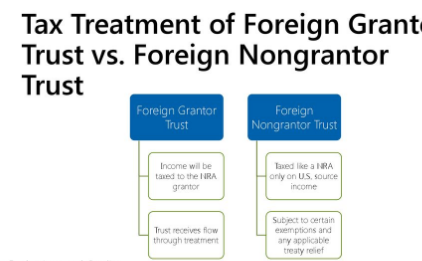In general, a lot of people get confused between the Foreign Grantor Trust (FGT) and Foreign Non-Grantor Trust (FNGT) and their tax criteria. Many proficient US tax advisors like Matthew Ledvina provides a clear insight on various taxes and emphasizes that people should be aware of all the tax guidelines concerning their income sources.
The taxation system of the US is full of complexity and the laws governing the taxes are somewhat perplexing. In fact, without the aid of a professional, it is quite difficult for individuals to understand the tax obligations that are applicable to different types of incomes.
Tax Aspect of Foreign Grantor Trust (FGT)
The US taxation rules identify Foreign Grantor Trust as a non-U.S. trust whose grantor or settler is a US individual. Pertaining to an FGT, the settlor/grantor acts as the owner of the trust. One important criterion for such trusts is that the assets held within the trust should be owned by an individual rather than the trust itself. All the incomes generated by the assets of the FGT are transparent and flows through the owner’s tax return. In other words, the income made by an FGT will be treated as the income of the owner and must reflect in the owner’s US Federal tax return. It is the responsibility of the owner or grantor to report all their trust income using IRS Form 3520.
Tax Reporting Duties for FGT
IRS or Internal Revenue Service is the tax authority of the US and it is the duty of the individuals associated with a Foreign Grantor Trust to provide all the tax-related information to IRS by filling and submitting certain forms.
• Trusts
The trust will have to file the form 3520-A, which comprises of 5 pages. The first two pages enquire about the general information of Trust including name and address along with the income statement and Balance Sheet of the Trust. The remaining
three pages of the Form comprise of Foreign Grantor Trust Owner Statement and
Beneficiary Statement. The 3520-A form is titled “Annual Information Return of
Foreign Trust with a U.S. Owner”.
• Owners
The owner of the FGT will have to fill the Form 3520 identified as “Annual Return to
Report Transactions with Foreign Trusts and Receipt of Certain Foreign Gifts”.
The 6-page form consists of 4 parts that require a variety of information
related to transfers, distributions, and gifts. Additionally, a signed copy of
page 3 of form 3520-A specifying the owner’s income from the trusts that are to
be reflected in his/her Federal tax return, should also be present alongside
Form 3520.
• Beneficiaries
Beneficiaries also, have to fill Form 3520 and present it along with page 4 of Form 3520-A, which is the beneficiary’s statement. The beneficiary statement contains information that is needed by the beneficiary while filing for individual
Federal tax returns.
Tax Aspects of Foreign Non-Grantor Trust (FNGT)
An FNGT is a trust, which either does not have a US settlor/grantor or the US settlor/grantor has deceased. According to the US taxation rules, an FNGT trust is the one in which the assets are held by the trusts itself and not by any other person. In the case of FNGTs, it is not possible for the IRS to levy taxes directly on the grantor or settlor. As an alternative, IRS charge taxes on the distributions that are made to the beneficiaries of the trust.
How Beneficiaries of FNGTs Pay Taxes
Unlike FGT, there is no need to fill 3520-A form by the trust. Instead, the IRS requires that the FNGT should prepare Foreign Non-Grantor Trust Beneficiary Statements (FNGTBS), which will be created separately for each beneficiary of the trust. In case the distributions are made from the principal amount or the Corpus of the trust, no tax will be charged. However, if the distributions come from additional
income generated by the assets of the FNGT, then a certain amount of tax will
be levied on the distributions.
The yearly distribution made by the trust is known as Distributable Net Income
(DNI) and attracts tax rates equivalent to that of the regular income tax rates. However, in case the trust does not distribute DNI before the end of a year, IRS will consider it as Undistributed Net Income (UNI) and higher tax rates will be charged upon them. One of the most important things to notice is that the tax rates attracted by DNI depend upon the type of income, which may be interest, capital gains, dividends, etc. Thus it’s important to specify the type of income that beneficiary is receiving as distributions while preparing FNGTBS.
Comparing both the FGT and FGNT, it is quite clear that IRS levy taxes on these entities differently. Moreover, the tax obligations for both foreign trusts are
also quite dissimilar.





















